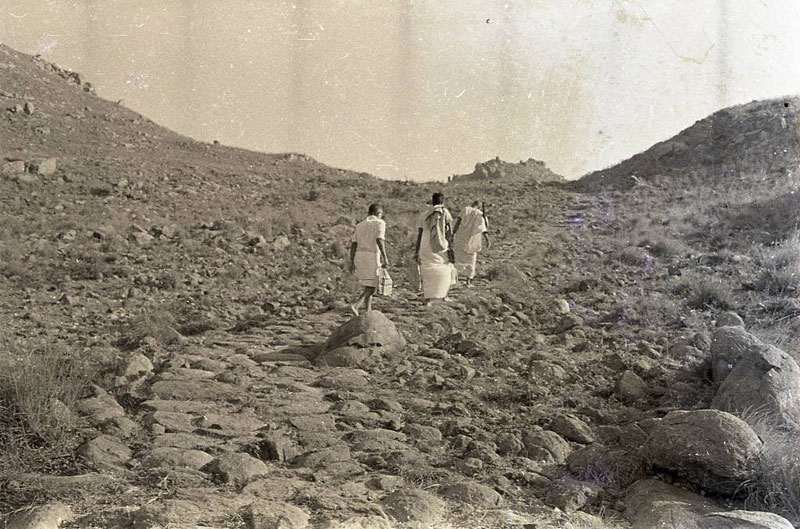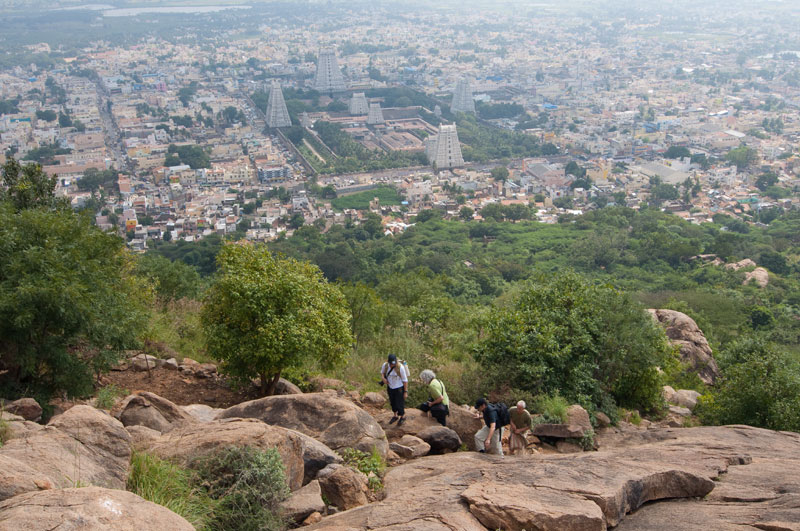In one of his answers Bhagavan stated that verses in the Skanda and Siva Puranas supported his assertion that Arunachala was a manifestation of God in the form of a mountain. After the hearing was over, Bhagavan selected some verses from these two works and passed them on to the court to supplement and support his evidence. Bhagavan entitled this collection of verses Sri Arunachala Linga Pramanya Vakyani, which means, ‘Sentences giving authoritative proof that Sri Arunachala is a lingam.’ The verses he selected are given below.
From the Skanda Mahapurana,
Maheswara Kanda, Part Three,
Arunachala Mahatmyam, First Half:
CHAPTER ONE
Sanaka said [to Brahma]:
9
O Treasure of Grace! O Foremost of Devas! On earth there are Siva lingams which are divine, which are installed by human beings and siddhas, and which are composed of the [five] elements.
10
Tell me, which lingam in the landmass that contains India is immaculate, divine, of undefilable glory, self-originated and effulgent?
Brahma replied:
22
Hear how in ancient days the wonderful and effulgent Siva, who is full of motiveless grace, manifested with the name of Arunadri [one of the names of Arunachala].
23
Narayana and I were born from Him who transcends the universe.
24
Once we two, who were self-born, began to argue with other.
25, 31
Seeing the dreadful enthusiasm with which we were fighting with each other, Iswara, who is the embodiment of grace, …rose as a column of fire between us.
Brahma said:
50
He [Lord Siva] assumed the nature of a motionless lingam in the form of Arunachala.
51
This indeed is the effulgent lingam, the sole cause of the universe, which is visible on earth and which is renowned as Arunadri.
CHAPTER TWO
Brahma and Vishnu prayed [to Lord Siva]:
31
Withdrawing Your effulgence, abide as a motionless lingam named Arunachala in order to bestow grace upon the world.
Brahma said:
50
He [Lord Siva] assumed the nature of a motionless lingam in the form of Arunachala.
51
This indeed is the effulgent lingam, the sole cause of the universe, which is visible on earth and which is renowned as Arunadri.
CHAPTER FOUR
Iswara said:
37
I truly abide here on earth in the form of an effulgence named Arunachala [in order to bestow] the attainment [of liberation].
38
Since It [this hill] removes the cruel accumulation of sins from all the worlds, and since bondage becomes non-existent when ones sees It, It is [named] Arunachala.
40
In ancient days, when a fight arose between Brahma and Vishnu, who were both born from a part of Me, I manifested myself in the form of an effulgence in order to remove their delusion.
43
At their further request I, who was in the form of effulgence, became the motionless lingam named Arunadri.
CHAPTER FIVE
Devi said to Gautama:
24
Siva told me: ‘I abide [on earth] with the name Arunachala,’ and said that I should hear the glory of Arunachala from your lips.
Gautama said:
42, 43
In ancient days Brahma and Vishnu, who had come into existence from a part of the effulgence of Siva, but who had become egotistical, fought with a desire to conquer each other.
43, 44
In order to subdue the pride of these two, who were fighting in this manner, Sadasiva, who is worthy to be meditated on by yogis, assumed the form of a column of fire without beginning, middle or end, and stood between them, illuminating the ten directions.
47
At their further request, Devesa [Siva, the Lord of the devas] assumed the form of a motionless lingam [now] renowned as Arunadri. Tranquil He shines.
CHAPTER SIX
Iswara said:
21
I abide on earth as the form of Arunachala.
22
That effulgent form alone is called Arunachala.
23
This fiery effulgent form, unmanifest and of the nature of limitless glory, cooled down in order to protect the world.
CHAPTER SEVEN
The devas said:
9
O Bhagavan! O Arunadrisa [Arunachala]! You who do good to the whole world! Although You are of the form of fire, You shine in the world, having become tranquil.
Gautama said:
5
Having been prayed to by the devas, Sriman Arunadrisa gradually cooled down and became perfectly tranquil as Arunachala in order to protect the world.
CHAPTER EIGHT
20
You [Lord Siva] are seen on earth as the famous Sonadri [another name of Arunachala].
17
Nowhere else on earth have I seen even one lingam in the form of a hill.
CHAPTER THIRTEEN
Brahma said:
42
This is Sadasiva Himself in the form of Arunachala, which is seen even as the supreme effulgence, the cause of creation, sustenance and dissolution.
44
This effulgent lingam is worshipped by all the devas. Because of this, the earth is considered to possess more dharma [than any other world].
From the Second Half of the Skanda Mahapurana:
CHAPTER FOUR
Nandikeswara said:
12
There God, Sambhu, the one who does what is good for the world, has Himself assumed the form of a hill and abides with the name Arunachala.
14
This hill, which is Parameswara Himself, is considered by maharishis to be superior to Sumeru, Kailasa and Mandara.
58
Neither Meru nor Kailasa nor Mandara are equal to Arunadri; they are abodes [of Lord Siva] filled with huge rocks, whereas this [Arunachala] is Girisa [the Lord of the Hill, one of the names of Siva] Himself.
CHAPTER SIXTEEN
Siva said:
27
For the welfare [of the world], may My effulgent form, which is motionless and eternal, abide here forever with the name Arunadri.
CHAPTER TWENTY
Gautama said:
21
This Arunadri is the hill of fire itself in a concealed form.
From the Siva Mahapurana,
Vidyeswara Samhita:
CHAPTER NINE
Iswara said:
21
Since this lingam rose up as a hill of fire, it shall be renowned as Arunachala.
41, 42
Since this formless column, which reveals My nature as Brahman, possesses the characteristics of a lingam, It shall be My lingam.
* * *
Since the Skanda Mahapurana and the Siva Mahapurana are two of the eighteen principal Puranas, these verses should have been enough to convince the court that Bhagavan’s assertions about the sanctity of Arunachala were backed up by an authoritative scriptural source. Unfortunately, the issue at stake was not the sanctity of the mountain but the ownership of it.
Property disputes in India tend to be protracted affairs, and this one was no exception. The final judgement was handed down in July 1940, more than six years after the original notification. The two parties seemed to have reached a settlement out of court, the terms of which were incorporated in the court’s decision. The Devasthanam reluctantly accepted that the Government was the sole owner of the hill. In return the Government granted the Devasthanam the right to maintain and repair all the religious property on Arunachala and to enjoy all the income from the sale of the grass that grew there. The Devasthanam was also given the right to collect dead wood from the hill and to graze its cattle there. The Government reserved for itself the right to authorise the construction of any new buildings on the hill.

In the fifty years that have passed since this judgment took effect, Tiruvannamalai has grown enormously. The town now has a population of over 100,000, all living at the foot of the hill, with many more living in outlying villages. As the population increased, nearly all the local forests were felled to meet the ever-increasing demand for timber and firewood. Arunachala was not spared. Nearly all the old trees on the hill were cut long ago, and sporadic reforestation projects in the last few years have failed to repair more than a fraction of the damage. The temple, although constrained by a lack of finances, has attempted to fulfil its obligation to the properties on the hill that it has been appointed to maintain. The other party, the Government, was, until the 1980s, quite successful in preventing new settlements from springing up on the hill and spoiling its sanctity. Unfortunately, neither party has been able to prevent or slow down the progressive environmental degradation of Arunachala’s slopes, nor have they been able to stop the annual fires, started by the local grass-cutters, which consume most of the mountain, destroying large tracts of vegetation and wildlife. The forests of Bhagavan’s youth have long since gone. With the local population still rapidly expanding, it will need a minor miracle to bring them back.
(First published in The Mountain Path, 1990, pp. 14-20)
Postscript, February 2015
As you can see from the date, this was written almost twenty-five years ago. The ‘minor miracle’ referred to in the last line did in fact happen. Arunachala now probably has more forest cover than at any time since the 19th century. The local forest department has clamped down on illegal grazing and wood-cutting, and also planted many trees on parts of the hill. An NGO, founded by an English devotee, Govinda, has reforested much of the southern side of the hill. This NGO has also made firebreaks all over the hill to prevent the spread of summer fires, and it has a huge body of volunteers who go up the hill to beat out any fires that break out during the summer months. The wildlife is slowly returning. Some of the trees that are flourishing on the upper slopes of the hill have actually sprouted from ancient roots that stayed alive during the century when fires, wood-cutters and grazers were destroying everything above ground level. If this welcome trend continues, in a few years’ time there will be a mature native forest covering almost all of the hill.
